The New York Renaissance, also known as the Renaissance Big R Five and as the Rens, were the first black-owned, all-black, fully-professional basketball team in history, established in October 1923, by Robert "Bob" Douglas. They were named after the Renaissance Casino and Ballroom through an agreement with its owner, in return for the use of that facility as their home court. The Casino and Ballroom at 138th Street and Seventh Avenue in Harlem was an entertainment complex that included a ballroom, which served as the Rens' home court. The team eventually had its own house orchestra and games were often followed by a dance. Their subsequent financial success shifted the focus of black basketball from amateurism to professionalism. Initially, the Rens played mostly in Harlem, but Douglas soon realized they could book more games on the road, in larger-capacity venues, and took up barnstorming across the country for more lucrative payouts. The Renaissance are also the topic of the 2011 documentary On the Shoulders of Giants.
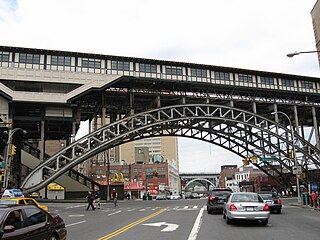
125th Street, co-named Martin Luther King Jr. Boulevard, is a two-way street that runs east–west in the New York City borough of Manhattan, from First Avenue on the east to Marginal Street, a service road for the Henry Hudson Parkway along the Hudson River in the west. It is often considered to be the "Main Street" of Harlem.
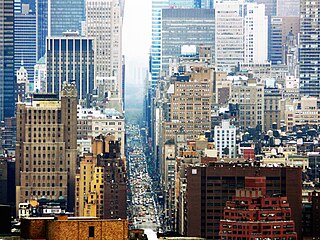
Seventh Avenue—co-named Fashion Avenue in the Garment District and known as Adam Clayton Powell Jr. Boulevard north of Central Park—is a thoroughfare on the West Side of the borough of Manhattan in New York City. It is southbound below the park and a two-way street north of it.
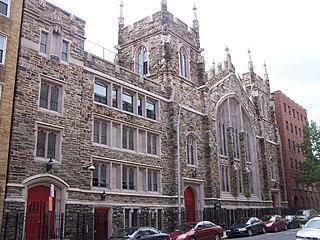
The Abyssinian Baptist Church is a Baptist megachurch located at 132 West 138th Street between Adam Clayton Powell Jr. Boulevard and Lenox Avenue in the Harlem neighborhood of Manhattan, New York City. It is affiliated with the National Baptist Convention, USA and American Baptist Churches USA.
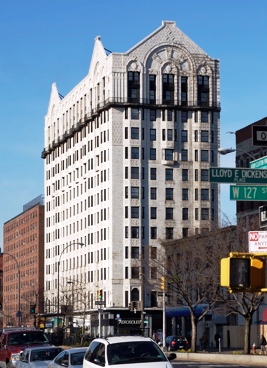
The Hotel Theresa is located at 2082–96 Adam Clayton Powell Jr. Boulevard between West 124th and 125th Streets in the Harlem neighborhood of Manhattan, New York City. In the mid-20th century, it was a vibrant center of African American life in the area and the city.

Manhattanville is a neighborhood in the New York City borough of Manhattan bordered on the north by 135th Street; on the south by 122nd and 125th Streets; on the west by Hudson River; and on the east by Adam Clayton Powell Jr. Boulevard and the campus of City College.

The Dunbar Apartments, also known as the Paul Laurence Dunbar Garden Apartments or Dunbar Garden Apartments, is a complex of buildings located on West 149th and West 150th Streets between Frederick Douglass Boulevard/Macombs Place and Adam Clayton Powell Jr. Boulevard in the Harlem neighborhood of Manhattan, New York City. They were built by John D. Rockefeller Jr. from 1926 to 1928 to provide housing for African Americans, and was the first large cooperative aimed at that demographic. The buildings were designed by architect Andrew J. Thomas and were named in honor of the noted African American poet Paul Laurence Dunbar.

Sugar Hill is a National Historic District in the Harlem and Hamilton Heights neighborhoods of Manhattan, New York City, bounded by West 155th Street to the north, West 145th Street to the south, Edgecombe Avenue to the east, and Amsterdam Avenue to the west. The equivalent New York City Historic Districts are:
Mount Morris Park Historic District is a 16-block historic district in west central Harlem, Manhattan, New York City. It was designated by the New York City Landmarks Preservation Commission in 1971, and is part of the larger Mount Morris Park neighborhood. The boundaries are West 118th and West 124th Streets, Fifth Avenue, and Adam Clayton Powell Jr. Boulevard.

The Harlem YMCA is located at 180 West 135th Street between Lenox Avenue and Adam Clayton Powell Jr. Boulevard in the Harlem neighborhood of Manhattan, New York City. Built in 1931-32, the red-brown brick building with neo-Georgian details was designed by the Architectural Bureau of the National Council of the YMCA, with James C. Mackenzie Jr. as the architect in charge. It replaced the building from 1919 across the street. Inside the building is a mural by Aaron Douglas titled "Evolution of Negro Dance." The building was declared a National Historic Landmark in 1976, and was designated a New York City Landmark in 1998.
John Raymond Jones was the last Grand Sachem of Tammany Hall, a New York City Councilman for Harlem, a district leader, ran the Carver Democratic Club, and was Adam Clayton Powell's campaign manager in 1958, opposing Tammany Hall, and Carmine DeSapio.
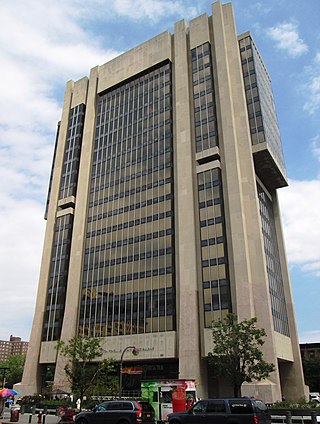
The Adam Clayton Powell Jr. State Office Building, originally the Harlem State Office Building, is a nineteen-story, high-rise office building located at 163 West 125th Street at the corner of Adam Clayton Powell Jr. Boulevard in the Harlem neighborhood of Manhattan, New York City. It is named after Adam Clayton Powell Jr, the first African-American elected to Congress from New York. It was designed by the African-American architecture firm of Ifill Johnson Hanchard in the shape of an African mask in the Brutalist style. It is the tallest building in Harlem, overtaking the nearby Hotel Theresa.

The Metropolitan Baptist Church, located at 151 West 128th Street on the corner of Adam Clayton Powell Jr. Boulevard in the Harlem neighborhood of Manhattan, New York City, was originally built in two sections for the New York Presbyterian Church, which moved to the new building from 167 West 111th Street. The chapel and lecture room were built in 1884-85 and were designed by John Rochester Thomas, while the main sanctuary was constructed in 1889-90 and was designed by Richard R. Davis, perhaps following Thomas's unused design. A planned corner tower was never built.

St. Philip's Episcopal Church is a historic Episcopal church located at 204 West 134th Street, between Adam Clayton Powell Jr. Boulevard and Frederick Douglass Boulevard in the Harlem neighborhood of Manhattan, New York City. Its congregation was founded in 1809 by free African Americans worshiping at Trinity Church, Wall Street as the Free African Church of St. Philip. First located in the notorious Five Points neighborhood, it is the oldest black Episcopal parish in New York City. Historically, it was extremely influential both while located in lower Manhattan and as an institution in Harlem, and many of its members have been leaders in the black community. In 2020, it reported 188 members, 111 average attendance, and plate and pledge income of $224,827.

The St. Aloysius Catholic Church is a Catholic parish in the Archdiocese of New York, located at 209-217 West 132nd Street between Adam Clayton Powell Jr. Boulevard and Frederick Douglass Boulevard in the Harlem neighborhood of Manhattan, New York City.
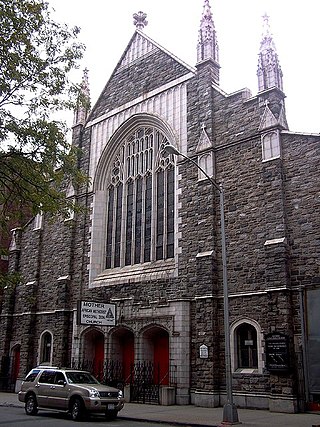
The Mother African Methodist Episcopal Zion Church, also known as "Mother Zion", located at 140–148 West 137th Street between Adam Clayton Powell Jr. Boulevard and Lenox Avenue in the Harlem neighborhood of Manhattan, New York City, is the oldest African-American church in New York City, and the "mother church" of the African Methodist Episcopal Zion conference.

The Harlem Alhambra was a theater in Harlem, New York, built in 1905, that began as a vaudeville venue. The building still stands at 2108-2118 Adam Clayton Powell Jr. Boulevard at the South-West corner of 126th Street. The architect was John Bailey McElfatrick (1829–1906) who, based in Manhattan, founded the architectural firm John B. McElfatrick & Son – builder of 100 theaters. Construction on the structure commenced late 1902 by its original owner, Harlem Auditorium Amusement Company.

The Renaissance Ballroom & Casino was an entertainment complex at 2341–2349 Adam Clayton Powell Jr. Boulevard in the Harlem neighborhood of Manhattan in New York City. When opened in 1921, it included a casino, ballroom, 900-seat theater, six retail stores, and a basketball arena. It spanned the entire eastern frontage of Adam Clayton Powell Jr. Boulevard between 137th and 138th Streets.

David Hazlitt King Jr. was a prominent Gilded Age constructor, developer, hotelier, investment banker, art collector, President of the New York City Park Commission, and one of the initial Directors of the Metropolitan Opera House Company of New York. King is known for the assembly of the Statue of Liberty as well as the building of its plinth, constructing Washington Square Arch and Stanford White's Madison Square Garden.























